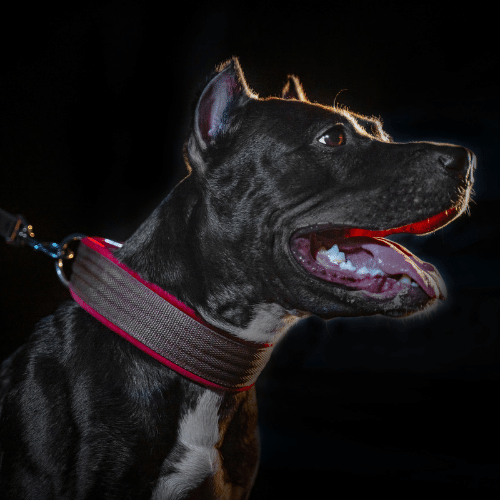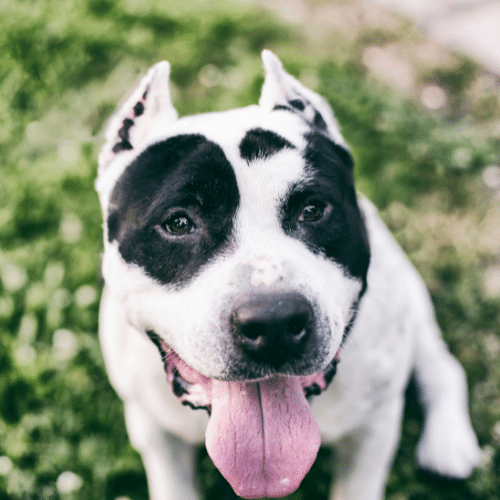Black and white pitbull dogs carry a specific type of coat color gene, called a white spotting gene.
Regardless of which pitbull breed they belong to, having a lot of white in their coat increases their risk of deafness.
But in every other respect, they will be just like the other members of their breed.
Adopting a Black and White Pitbull
Many of these dogs can be adopted from breeders. Usually, you can find breeders that specialize in particular colors and patterns (such as also the Razor Edge Pitbull), which can help you find exactly what you’re looking for. Because these dogs are prone to so many health conditions that are preventable with the right testing, we highly recommend purchasing from a breeder.
Breeders are often more expensive. However, this is largely because breeders perform the correct health testing, which prevents unhealthy litters of puppies from being reduced. You may end up paying more money upfront, but this lowers the chance that you’ll need to spend $4,000 per hip on your dog when they get hip dysplasia. It saves you significant amounts of money in vet bills.
Most breeders charge around $1,200 for their dogs. However, extremely high-quality dogs can cost as much as $10,000.
These dogs are quite common at animal shelters. However, remember that many dogs are misidentified as pitbulls by animal shelter workers. Therefore, just because a dog is advertised as a pitbull doesn’t mean they actually are. Usually, shelters will charge $50 to $300 per dog. This covers all of their vet bills and other care they needed while at the shelter.
Many shelters may charge less for these dogs, as they often sit for longer in shelters due to misconceptions about their temperaments. Many people are slow to adopt a pitbull. Therefore, you may get these dogs even cheaper. However, you should keep in mind that these dogs often have unknown pasts. Therefore, they may be a bit unhealthier than dogs from breeders.
If you do decide to adopt these dogs from a breeder, be sure that you consider the lower cost a down payment. You should have at least $5,000 in an emergency fund to pay for any health emergencies and surgeries.
No matter where you adopt your dog from, be sure to ask for health records. Breeders and rescues should readily turn them over. If they don’t, you should be very cautious. It usually means that the dog hasn’t gotten the proper health care. Of course, many rescues won’t have the dog’s complete health records. However, they should be able to share what the dog has been treated for and the vaccinations they have received since their arrival.
Training and exercise needs of a black and white pitbull
Like all pitbulls and other breeds, these black and white dogs will need regular socialization. If you simply leave a puppy at home all day, these dogs will not learn how to interact with the outside world. When they are finally met with a new and unusual situation, they will often become fearful, which can increase the chance of aggression.
Therefore, it is important to introduce them to a wide variety of different people and animals at a young age. Puppy classes are a great option for this. It provides them with a chance to train and socialize at the same time in a safe, controlled environment. Plus, you know all the other puppies at the class are properly vaccinated and safe for yours to be around.

Luckily, these dogs are very easy to socialize with due to their confident nature. Their default state is to love everyone, so they quickly take to new people. They are intelligent and people-oriented, so they often train easily. The only major problem is that they can sometimes become overexcited, which can cause them to block out commands. They cannot be trusted off-leash for this reason.
Regular exercise is important for this breed. Often, this isn’t terribly difficult, as these dogs will happily do just about anything if their people are involved. Moderate walks and plenty of playtime are all they need in most cases. If you have children in your family, the dog will often play with them for hours.
The high prey drive of this breed means that the Pitbulls need to be carefully supervised with cats and smaller dogs.
Despite the fact that they aren’t huge dogs, this breed has a higher than average occurrence of hip dysplasia. This is a serious problem that occurs when the hip joint does not fit together properly. This causes excess wear and tear of the joint, leading to everything from pain to lameness. Medication and supplements are enough to treat some dogs, but others need fairly expensive surgery. As many as 23% of these dogs have some sort of hip problem.
They are also prone to patella (kneecap) problems. Their kneecap usually sits in a joint on their femur, which allows them to move around freely as they walk. However, in some cases, it can slip out of place. Some dogs don’t have a kneecap and groove that line up well together, increasing the chance of dislocation. Elbow problems affect as many as 17% of dogs.
Some heart problems, such as congenital defects, are also a problem. Most dogs cared for by professional breeders are tested for these problems before they are bred. It isn’t odd for a dog to have a congenital heart defect but not show symptoms until much later in life. Therefore, testing is important to ensure that affected dogs aren’t bred, producing more affected puppies.
Degenerative myelopathy affects about 18% of pitbulls, though many others are carriers. This is a condition that affects the spinal cord. It results in the slow loss of feeling in the hips and back legs, leading to weakness and then paralysis. Symptoms may resemble hip dysplasia in some cases, which can make diagnoses confusing, especially in white and black pitbulls, as they are prone to both conditions.
We do know that this disease is caused by a genetic mutation that occurs in a number of breeds, including all pitbulls. It is recessive, so dogs have to inherit two copies to be affected. There is currently no treatment for this disease. Instead, supportive care simply helps the dog remain standing for as long as possible, which includes keeping the dog physically active.
This breed is at an increased risk of parvovirus than other breeds when not vaccinated. Therefore, it is recommended that these dogs are appropriately vaccinated. This will involve multiple vaccinations when the dog is young, as well as a yearly booster.
Pitbulls, in general, are prone to Demodex Mange. This is not a very contagious disease, but it can be very difficult to treat if it gets on a white and black pitbull. There are two main types: localized and generalized. Localized mange typically involved patches of hair loss and are relatively minor.
Generalized symptoms are more severe and cause serious illnesses in some cases. Usually, hair loss will affect the whole body, not just specific spots. The skin may bleed and scab over. While the localized variant is not genetic, the generalized type is caused by immunodeficiency. If a dog carries the gene for this deficiency, they have a higher chance of developing generalized symptoms when infected.
Ivermectin injections are the most common treatment for this disease and are widely available at most veterinary clinics. Oral medications can be used as well, especially if the injections are not effective.

The American Pit Bull Terrier does not require regular grooming, except an occasional brushing session to remove the excess fur they’re shedding. These dogs do shed quite a bit, so some occasional brushing is often required. They will often shed extra during certain times of the year, especially as the seasons change. Brushing will also help keep their coat clean and spread around their natural oils, which will result in a healthier coat.
They will need an occasional bath when they get dirty. Often, they may develop a slightly oily coat and a doggie smell, which is a clear sign that they need a bath. It is important to clean them with a gentle shampoo, as they are prone to some skin problems.
Because they are white, they may appear dirtier than they actually are. You can get dog wipes if you want to keep their white coat looking clean, but it typically isn’t recommended to bathe them every time they get dingy. This can dry out their skin. Brushing sessions can help with their coat cleanliness, but wet wipes designed for dogs can help if your canine steps in some mud with their white feet.
Like all dogs, you will need to trim their nails regularly. Usually, this should be done about every two months, but it depends on your dog’s activity level and environment. Very active dogs will wear their nails down somewhat by themselves.
Their teeth will need regularly brushed with dog-safe toothpaste. Periodontal disease in dogs is extremely dangerous and leaves them open for all sorts of diseases. For this reason, keeping your dog’s teeth clean is extremely important. You will also have to schedule teeth cleanings with your vet to prevent serious periodontal disease from occurring.
What Does the Black and White Pitbull Look Like?
A black and white Pitbull looks like a normal Pitbull with a beautiful bi-colored coat.
Like other dogs in the breed, they have a smooth, short, and glossy coat. Pitbulls are also very muscular due to their athletic nature. These dogs have sharp-looking eyes as well as pointy ears. Pitbull nose colors differ depending on their genetic make-up.
As stated earlier, black and white Pitbull coats can either be small specks, large markings, or even shades throughout the body. There is no specific ratio of black to white or white to black since it all depends on the parent’s genes.
This is video of black and white Pitbull puppies I found on YouTube.
Check out this video I found on YouTube that showcases a litter of pitbull puppies, and some are black and white puppies.Pitbull Puppy for sale Girl Black/Brindle and White
FAQ
What is the rarest color of Pitbull?
How much does a black and white pitbull cost?